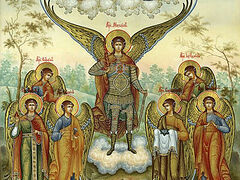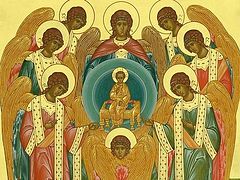 Today is one of the most well-known days in the Russian Orthodox calendar, recognized even by those who attend church only sporadically. Officially, it is called the “Synaxis of Archangel Michael and All the Bodiless Powers of Heaven: Archangels Gabriel, Raphael, Uriel, Selaphiel, Jegudiel, Barachiel, and Jeremiel.” The faithful simply call it “Michaelmas.”
Today is one of the most well-known days in the Russian Orthodox calendar, recognized even by those who attend church only sporadically. Officially, it is called the “Synaxis of Archangel Michael and All the Bodiless Powers of Heaven: Archangels Gabriel, Raphael, Uriel, Selaphiel, Jegudiel, Barachiel, and Jeremiel.” The faithful simply call it “Michaelmas.”
The significance of this feast is clear: St. Michael is the “commander-in-chief” (Greek archistrategos) of countless legions of good angels. These angels wage war for the souls of humanity against their fallen counterparts, who become darkened and become demons out of envy and malice. (It is worth noting that such transformations can also happen to people overwhelmed by pride.) Archangel Michael is a valiant warrior, a glorious knight of God, defending His honor and dignity. Indeed, he bears God’s title not only on his shield but even in his very name. The theophoric name “Michael” (Mikha’el in Hebrew) translates as a rhetorical exclamation: “Who is like unto God?!” The answer, of course, is self-evident.
In the Old Testament Book of Daniel, Archangel Michael appears as the prince of God’s chosen people, Israel. He defends them from the “prince” (that is, the rival angel) of the “kingdom of Persia.” In the New Testament Book of Revelation (the Apocalypse), Michael leads the final, eschatological battle against the “dragon” (Satan himself, or the Devil) and his vile minions. This battle has become a favorite subject of Christian iconography, painting, and engraving, immediately calling to mind the expressive imagery of Dürer.
For Christians, however, Michael is not only a warrior but also an angel of mercy, an intercessor for people before God. Together with Archangel Gabriel, he stands by God’s throne. He is a guide for human souls, helping them enter the gates of the Heavenly Jerusalem. According to tradition, he also carried the body of the reposed Virgin Mary to Heaven.
 Archangel Michael, St. Andrei Rublev. Tretyakov Gallery, Moscow. In Russia, Michael was considered the patron of princes (military leaders) and, in general, of the arduous path of warfare. Yet this does not mean that the Archangel must always appear warlike. One needs only to look at his image from the Monastery of Sinai. Visitors to the Tretyakov Gallery will never forget Andrei Rublev’s icon, depicting a romantically thoughtful Archangel. Perhaps he reflects sorrowfully on the violence that has engulfed our world.
Archangel Michael, St. Andrei Rublev. Tretyakov Gallery, Moscow. In Russia, Michael was considered the patron of princes (military leaders) and, in general, of the arduous path of warfare. Yet this does not mean that the Archangel must always appear warlike. One needs only to look at his image from the Monastery of Sinai. Visitors to the Tretyakov Gallery will never forget Andrei Rublev’s icon, depicting a romantically thoughtful Archangel. Perhaps he reflects sorrowfully on the violence that has engulfed our world.
Michaelmas is an ancient feast, though the exact time of its establishment is unknown. In Constantinople, two churches were dedicated to Archangel Michael. In ancient Menologies, the feast’s name varies: “Synaxis of Archangel Michael,” “Synaxis of Michael and Gabriel,” “Synaxis of the Angels,” “Synaxis of the Archangels”... In the Coptic calendar of the fifteenth century, a feast in honor of Michael and the Bodiless Powers is even observed on the eighth day of every month! The renowned church historian Prof. Vasily Vasilievich Bolotov proved the Egyptian origin of this feast. In this case, it replaced the archaic feast of the Theophany, which was assigned a new date—January 6 (Julian calendar).
I wish all those celebrating their name day to support their Heavenly patron in his noble battle by first overcoming the evil within their own soul!



